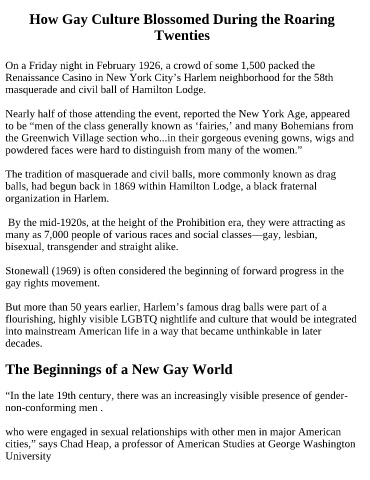Page 454 - ILIAS ATHANASIADIS AKA RO1
P. 454
How Gay Culture Blossomed During the Roaring
Twenties
On a Friday night in February 1926, a crowd of some 1,500 packed the
Renaissance Casino in New York City’s Harlem neighborhood for the 58th
masquerade and civil ball of Hamilton Lodge.
Nearly half of those attending the event, reported the New York Age, appeared
to be “men of the class generally known as ‘fairies,’ and many Bohemians from
the Greenwich Village section who...in their gorgeous evening gowns, wigs and
powdered faces were hard to distinguish from many of the women.”
The tradition of masquerade and civil balls, more commonly known as drag
balls, had begun back in 1869 within Hamilton Lodge, a black fraternal
organization in Harlem.
By the mid-1920s, at the height of the Prohibition era, they were attracting as
many as 7,000 people of various races and social classes—gay, lesbian,
bisexual, transgender and straight alike.
Stonewall (1969) is often considered the beginning of forward progress in the
gay rights movement.
But more than 50 years earlier, Harlem’s famous drag balls were part of a
flourishing, highly visible LGBTQ nightlife and culture that would be integrated
into mainstream American life in a way that became unthinkable in later
decades.
The Beginnings of a New Gay World
“In the late 19th century, there was an increasingly visible presence of gender-
non-conforming men .
who were engaged in sexual relationships with other men in major American
cities,” says Chad Heap, a professor of American Studies at George Washington
University

